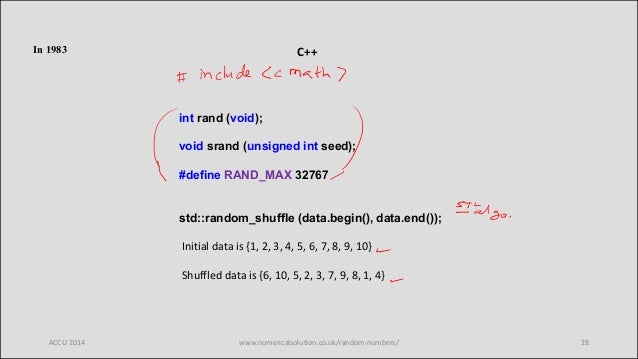Random number generators fulfill a number of purposes. Everything from games to simulations require a random number generator to work properly. Randomness finds its way into business what-if scenarios as well. In short, you need to add random output to your application in many situations.
/native-traktor-pro-3.html. TRAKTOR PRO 3 sees a series of changes to our audio engine, designed with club- sized sound systems in mind. New Elastique 3 time-stretching, an improved master limiter, and industry-mixer modeling options mean that whatever your style, and whatever you.
Creating a random number isn’t hard. All you need to do is call a random number function as shown in the RandomNumberGenerator example:
- Randomise Function. I have been working with many c projects but never came across randomize function. Is it user defined or inbuilt function? Considering that most of the instructors in question also teach C as if it were C - using the stdio functions instead of iostream, not covering classes at all, etc. I would say this.
- Random Number Generation C It is often useful to generate random numbers to produce simulations or games (or homework problems:) One way to generate these numbers in C is to use the function rand.
- These are not standard C or C functions. In standard C and C there are srand and rand which are part of the header. These functions are probably part of Turbo C to improve compatibility with Turbo Pascal, where randomize and random are the default random number generator. Unfortunately the quality of this generator sucks very very much.
Actually, not one of the random number generators in the Standard Library works properly — imagine that! They are all pseudorandom number generators: The numbers are distributed such that it appears that you see a random sequence, but given enough time and patience, eventually the sequence repeats.
In fact, if you don’t set a seed value for your random number generator, you can obtain predictable sequences of numbers every time. How boring. Here is typical output from this example:
The first line of code in main() sets the seed by using the system time. Using the system time ensures a certain level of randomness in the starting value — and therefore a level of randomness for your application as a whole. If you comment out this line of code, you see the same output every time you run the application.


C library function - rand - The C library function int rand(void) returns a pseudo-random number in the range of 0 to RANDMAX.
The example application uses rand() to create the random value. When you take the modulus of the random number, you obtain an output that is within a specific range — 12 in this case. The example ends by adding 1 to the random number because there isn’t any month 0 in the calendar, and then outputs the month number for you.
The Standard Library provides access to two types of pseudorandom number generators. The first type requires that you set a seed value. The second type requires that you provide an input value with each call and doesn’t require a seed value. Each generator outputs a different data type, so you can choose the kind of random number you obtain.
The table lists the random number generators and tells you what data type they output.
How To Use Randomize Function In Dev C Online
| Function | Output Type | Seed Required? |
|---|---|---|
| rand | integer | yes |
| drand48 | double | yes |
| erand48 | double | no |
| lrand48 | long | yes |
| nrand48 | long | no |
| mrand48 | signed long | yes |
| jrand48 | signed long | no |
Now that you know about the pseudorandom number generators, look at the seed functions used to prime them. The following table lists the seed functions and their associated pseudorandom number generator functions.
How To Use Randomize Function In C++
| Function | Associated Pseudorandom Number Generator Function |
|---|---|
| srand | rand |
| srand48 | drand48 |
| seed48 | mrand48 |
| lcong48 | lrand48 |